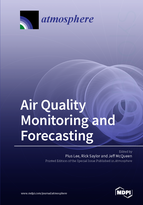Air Quality Monitoring and Forecasting
A special issue of Atmosphere (ISSN 2073-4433). This special issue belongs to the section "Air Quality".
Deadline for manuscript submissions: closed (30 June 2017) | Viewed by 73388
Special Issue Editors
2. NOAA/Air Resources Lab National Air Quality Forecasting Capability Project Leader, NCWCP, College Park, MD 20740, USA
Interests: process research; meteorological and atmospheric composition measurements that advance knowledge and prediction accuracy for air pollution events
Special Issues, Collections and Topics in MDPI journals
Interests: atmospheric chemistry and atmosphere-surface exchange
Special Issue Information
Dear Colleagues,
Atmosphere dedicates this special issue to air quality monitoring and forecasting. Forecasting is a vital tool for local health and air quality managers to make informed short-term decisions on remedial and mitigation measures to reduce exposure risks for their residents. Forecasting tools enable them to issue air quality advisories to curb pollution by limiting vehicular traffic by encouraging car-pooling and offering free public transportation. Air quality monitoring from the perspective of air managers serves a dual purpose of evaluating the skill of their forecasting tools and deriving long-term trends of major air pollutants that impact their constituents. Epidemiologists also use long term monitored data to understand air pollution related diseases and mortality rates to support public health policy decisions. This Special Issue reinforces the importance of these tools by leveraging their collective strengths.
Public health is under a constant threat by air pollution across the world in various degrees and manifestations. In some countries with rapid economic growth the abrupt increased occurrences of poor air quality over cities and their downwind regions are attracting worldwide attention. The adverse health effects suffered by the public are reflected in billions of dollars in lost productivity, hospital admissions due to contraction and exacerbation of respiratory, asthmatic and cardiovascular diseases, and increases in mortality rates. This is especially true in rapidly developing countries. On the other hand, many cities in developed countries are seeing changes in their atmospheric chemical regimes from nitrogen oxide (NOx) saturated regimes towards NOx limiting regimes. Furthermore, ozone and ozone precursors transported from areas upwind become important source of “background ozone” as local generation of ozone plays a lesser role due to reduced NOx emissions in the developed countries. It is now clear that air pollution is a global problem and that air quality monitoring, forecasting and mitigation should be a local effort conducted in concert with global partners.
In light of the global, trans-continental, and rapidly changing chemical and emission characteristics of the world's air quality, we invite you to contribute articles to this special issue by reporting on observation and modeling and policy-relevant studies about air quality monitoring and forecasting for regional and/or global applications. Solicited contributions include but are not limited to: atmospheric chemical studies through observation and/or forecast modeling of pollution emission, transport, transformation, removal, fate of air pollutants and their health impact on humans. Articles on chemical analysis and operational air quality forecasting performance and evaluation are also encouraged.
Dr. Pius Lee
Dr. Rick Saylor
Mr. Jeff McQueen
Guest Editors
Manuscript Submission Information
Manuscripts should be submitted online at www.mdpi.com by registering and logging in to this website. Once you are registered, click here to go to the submission form. Manuscripts can be submitted until the deadline. All submissions that pass pre-check are peer-reviewed. Accepted papers will be published continuously in the journal (as soon as accepted) and will be listed together on the special issue website. Research articles, review articles as well as short communications are invited. For planned papers, a title and short abstract (about 100 words) can be sent to the Editorial Office for announcement on this website.
Submitted manuscripts should not have been published previously, nor be under consideration for publication elsewhere (except conference proceedings papers). All manuscripts are thoroughly refereed through a single-blind peer-review process. A guide for authors and other relevant information for submission of manuscripts is available on the Instructions for Authors page. Atmosphere is an international peer-reviewed open access monthly journal published by MDPI.
Please visit the Instructions for Authors page before submitting a manuscript. The Article Processing Charge (APC) for publication in this open access journal is 2400 CHF (Swiss Francs). Submitted papers should be well formatted and use good English. Authors may use MDPI's English editing service prior to publication or during author revisions.
Keywords
- Air Quality and atmospheric composition modeling
- Atmospheric chemical observation and monitoring
- Air quality forecasting
- Air pollutant related epidemiology and exposure studies
- Climate impact on air quality forecasting







